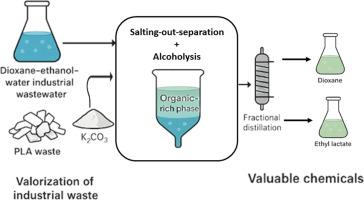汇聚废物流:共沸废水和生物塑料固体的双重增值
IF 6.7
2区 工程技术
Q1 ENGINEERING, CHEMICAL
引用次数: 0
摘要
工业废水和塑料固体废物的有效增值是可持续化学制造的主要挑战。本研究提出了一个综合策略,同时处理二氧六烷-乙醇-水三元共沸物的分离和聚乳酸(PLA)废物的升级回收。以碳酸钾(K2CO3)为双功能剂,将盐析分离和碱催化醇解合并为一个过程。K2CO3不仅有利于相分离,使二氧六环和乙醇的回收率达到99%,剩余水含量低于0.67 wt%,而且还能催化PLA在富有机物相内的解聚。脱水提取物作为反应介质,PLA有效地转化为乳酸乙酯,收率为65.18%。该方法建立了一种新的反应性共沸物裂解途径。所得乳酸乙酯和二恶烷可以通过分馏分离,不需要外部溶剂或进一步纯化。这种综合方法将两种具有挑战性的废物流,即共沸溶剂废水和聚乳酸塑料,通过整合和溶剂最小化的过程转化为增值产品。我们的工作为在废物密集型工业中耦合分离科学与催化增值提供了蓝图。本文章由计算机程序翻译,如有差异,请以英文原文为准。

Converging waste streams: dual valorization of azeotropic effluents and bioplastic solids
The efficient valorization of industrial wastewater and plastic solid waste constitutes a major challenge in sustainable chemical manufacturing. This study presents an integrated strategy that concurrently tackles the separation of dioxane–ethanol–water ternary azeotropes and the upcycling of polylactic acid (PLA) waste. By employing potassium carbonate (K2CO3) as a bifunctional agent, we combine salting-out separation and base-catalyzed alcoholysis into a single process. K2CO3 not only facilitates phase separation, achieving >99 % recovery of both dioxane and ethanol with a residual water content below 0.67 wt%, but also catalyzes the depolymerization of PLA within the organic-rich phase. The dehydrated extract serves as a reactive medium, efficiently converting PLA into ethyl lactate with a yield of 65.18 %. This approach establishes a novel reactive azeotrope-breaking pathway. The resulting ethyl lactate and dioxane can be separated via fractional distillation without requiring external solvents or further purification. This integrated methodology transforms two challenging waste streams, namely azeotropic solvent effluents and PLA plastics, into value-added products through a consolidated and solvent-minimized process. Our work provides a blueprint for coupling separation science with catalytic valorization in waste-intensive industries.
求助全文
通过发布文献求助,成功后即可免费获取论文全文。
去求助
来源期刊

Journal of water process engineering
Biochemistry, Genetics and Molecular Biology-Biotechnology
CiteScore
10.70
自引率
8.60%
发文量
846
审稿时长
24 days
期刊介绍:
The Journal of Water Process Engineering aims to publish refereed, high-quality research papers with significant novelty and impact in all areas of the engineering of water and wastewater processing . Papers on advanced and novel treatment processes and technologies are particularly welcome. The Journal considers papers in areas such as nanotechnology and biotechnology applications in water, novel oxidation and separation processes, membrane processes (except those for desalination) , catalytic processes for the removal of water contaminants, sustainable processes, water reuse and recycling, water use and wastewater minimization, integrated/hybrid technology, process modeling of water treatment and novel treatment processes. Submissions on the subject of adsorbents, including standard measurements of adsorption kinetics and equilibrium will only be considered if there is a genuine case for novelty and contribution, for example highly novel, sustainable adsorbents and their use: papers on activated carbon-type materials derived from natural matter, or surfactant-modified clays and related minerals, would not fulfil this criterion. The Journal particularly welcomes contributions involving environmentally, economically and socially sustainable technology for water treatment, including those which are energy-efficient, with minimal or no chemical consumption, and capable of water recycling and reuse that minimizes the direct disposal of wastewater to the aquatic environment. Papers that describe novel ideas for solving issues related to water quality and availability are also welcome, as are those that show the transfer of techniques from other disciplines. The Journal will consider papers dealing with processes for various water matrices including drinking water (except desalination), domestic, urban and industrial wastewaters, in addition to their residues. It is expected that the journal will be of particular relevance to chemical and process engineers working in the field. The Journal welcomes Full Text papers, Short Communications, State-of-the-Art Reviews and Letters to Editors and Case Studies
 求助内容:
求助内容: 应助结果提醒方式:
应助结果提醒方式:


